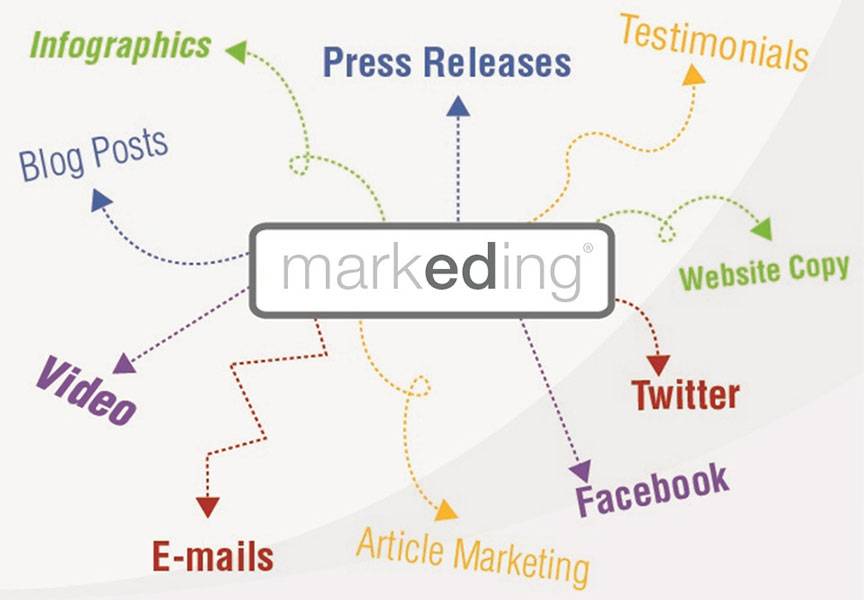After years of of teaching marketing courses, speaking and working one-on-one with clients, I noticed an unhealthy and very common mindset: a distaste, fear or restitance to marketing.
Sure, some issues stemmed from common marketing stereotypes (like the pushy infomercial guys or used car salespeople in commercials) but many wonderfully talented professionals who worked for or ran great companies saw marketing as self-serving, when in fact, it can be exactly the opposite.
As The Marketing Therapist®, I help passionate professionals breakdown issues to help get them working towards business breakthroughs. All of my work is rooted in education. So, I put on my educator hat and started sharing a new marketing mindset – markeding®.
As the mashup (marketing + education) name suggests, the best way to breakdown your issues with marketing is to retrain your brain to approach marketing with an educational focus.
Want that broken down in an even simpler way?
As yourself what you need to help your current and prospective customer understand.
Yep, that’s it. Write down what you are thinking. Answers can include how a product or service works, what your core values are, why you started your company, why you versus the competition and what your unique value proposition is.
The true academic meaning of marketing is maximizing exchanges. I prefer to make this definition sounds less transactional, so when I teach, I reinforce that “exchanges” means “relationships”. Anyone can make a sale, but to maximize a relationship (before and after the sale) you need to have an altruistic approach to marketing.
It all begins with education.
markeding® puts relationships at the center of the marketing strategy, and in doing so empowers your audience.
Reframe marketing as a relationship instead of a promotion – be a giver, not a taker.
Most of us know that getting to a sale typically takes seven touchpoints. Rarely, though, do we think of these touchpoints as moments in a relationship where we’re getting to know someone’s needs and wants.
Marketing is like marriage. You don’t walk into a bar, sidle up to someone, and ask them if they want to spend the rest of their life with you, right?; Building a meaningful relationship is a journey (not a destination) that starts with getting to know someone else to ensure your goals and values align.
In the same way, successful marketing doesn’t ask prospective customers to sign over a bunch of money on the first encounter. Instead, you use that first meeting to build awareness on both sides of the relationship. For you, it’s about learning the potential customer’s pain points as well as their needs. Meanwhile, they learn if and how your business can match those needs. In this way, markeding® is becomes an act of maximizing exchanges. In other words, you’ve established enough of a common ground that both parties are eager to move forwards.
Tackle the “why” question before you tackle marketing content.
One of the reasons traditional, car-salesman-like marketing continues to persist as a perception is that people fixate more on the “what’s” (like the press release, blog post or social media vehicle) before they really understand why they’re pursuing the relationship in the first place.
Instead, start with the why.
Let’s say you run an accounting services firm and are looking to entice smaller businesses. Instead of just putting out a press release announcing your availability, with markeding®, you would pause and ask what you need to help your audience understand.
One point is that accounting is often one of the things small businesses need to outsource most, since it’s time consuming and requires a very specific set of skills to do well. Keeping that in mind, put pushy marketing on hold and think about the kind of information this audience would actually find useful…pull them in with educational content.
Use content to create an informative experience.
Few need reminding nowadays that content is a vital part of any marketing strategy. Consider what you want to educate people on then start creating! For the accounting firm looking to entice small business, they might consider a blog post on how to hire the right CPA or bookkeeper or making a three-minute educational video mapping out the Q’s and A’s the process.
For any type of content, whether video, social media, the good old-fashioned blog post, or all three, make sure you understand the message you’re trying to teach your audience before you start to tinker with the tools.
A markeding® approach to content helps open doesn’t mean you’ll never run an expensive campaign or write a press release again. There’s a time and place for both those things. Remember that in today’s web and social centric world, we need to empower the person on the other end of the exchange a learning experience. Just like education is no longer a binge-and-purge exercise that shoves facts down someone’s throat and asks them to spit the information back up, marketing is no longer about bombarding your audience with ads and promotions.
When you take the markeding® approach, you’re more likely to do marketing ethically, and to pave the way for solid upstanding companies (non-profit or for-profit) to connect with the people they need. In doing so, the hope is we can eventually get rid of the pushy guy in sunglasses once and for all.
